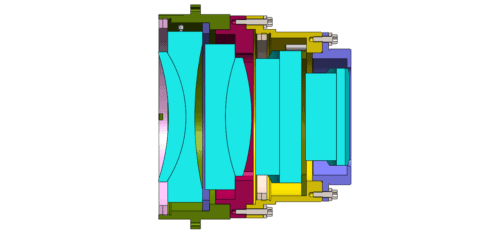Optical lenses are transparent materials used to refract light waves and control light beams. Two common types of optical lenses include cylinder lenses and acylinder lenses, and which one you should use depends on your application requirements. This article will cover the differences between cylinders and acylinders, including how they work, common applications, their benefits, and more to help you choose the best lens for your needs.
Cylinders
Cylinder lenses have different radii in the x and y axes, causing them to have a cylindrical or semi-cylindrical shape and allowing them to magnify images along only one axis. Their unique design focuses light to a one-dimensional line rather than a point. They can also be used to expand or condense light in one dimension.
At JML Optical, we use advanced CNC machining and X-Y axis polishing techniques along with metrology equipment to precisely engineer and produce cylindrical lenses and lens assemblies.
The primary function of cylinder lenses is to manipulate light based on the optical requirements of the application.
Many industries, such as industrial inspection, semiconductor manufacturing, entertainment, life sciences, and medical, rely on cylinder lenses for various applications, including:
- Imaging applications
- Laser scanning
- Computer technology
- Holographic lighting
- Spectroscopy
- Optical information processing
Cylinder lenses offer a variety of unique advantages, including:
- Ability to correct astigmatism
- Capable of adjusting the height of an image
- Compresses images into one dimension
- Creates circular laser beams out of anamorphic (elliptical) laser beams
Acylinders
Acylinders, also known as aspherical cylinders, have a generally cylindrical shape but do not have a constant radius of curvature. Acylinders are to cylinders as aspheres are to spheres. Acylindrical lenses focus light along one axis. A properly designed and manufactured acylinder produces a diffraction-limited line focus.
At JML Optical, our highly trained opticians use state-of-the-art fabrication machines and metrology equipment to produce acylinder lenses for a variety of demanding beam-shaping applications for industries such as medical, industrial, scientific, and more. Common applications include:
- To precisely control the shape of laser beams with the lowest possible levels of aberrations
- To produce diffraction-limited line images or collimated beams – this means that if a lens is being limited by diffraction, it is as good as theoretically possible and cannot be improved upon
- Lighting technology
- Laser scanners
- Spectroscopy
The benefits of acylinder lenses include:
- High levels of efficiency
- Minimized aberrations
- Reduced number of optimal components
- Decreased weight of optical system
- Sharpest possible line focus / collimation
Cylindrical and Acylindrical Lenses From JML Optical
Cylindrical and acylindrical lenses are used in various applications across diverse industries. At JML Optical, we fabricate our lenses using leading technology, machinery, and techniques to ensure precise, reliable lenses. As a leader in the design and volume manufacturing of lens assemblies and custom optics, we are capable of providing solutions that meet even your most challenging optical needs. For more information, or for help choosing the right lens for your application, contact our experts or request a quote today.




